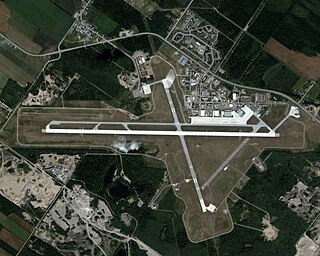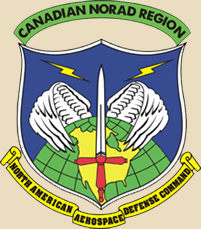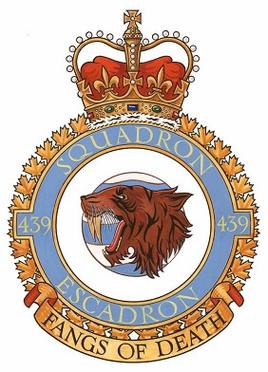The history of the Royal Canadian Air Force begins in 1914, with the formation of the Canadian Aviation Corps (CAC) that was attached to the Canadian Expeditionary Force during the First World War. It consisted of one aircraft that was never called into service. In 1918, a wing of two Canadian squadrons called the Canadian Air Force (CAF) was formed in England and attached to the Royal Air Force, but it also would never see wartime service. Postwar, an air militia also known as the Canadian Air Force was formed in Canada in 1920. In 1924 the CAF was renamed the Royal Canadian Air Force (RCAF) when it was granted the royal title by King George V. The RCAF existed as an independent service until 1968.

Shearwater Heliport, formerly known as Canadian Forces Base Shearwater and commonly referred to as CFB Shearwater and formerly named HMCS Shearwater, is a Canadian Forces facility located 4.5 nautical miles east southeast of Shearwater, Nova Scotia, on the eastern shore of Halifax Harbour in the Halifax Regional Municipality. Following a base rationalization program in the mid-1990s, the Canadian Forces closed CFB Shearwater as a separate Canadian Forces base and realigned the property's various facilities into CFB Halifax. These include:

A Canadian Forces base or CFB is a military installation of the Canadian Armed Forces. For a facility to qualify as a Canadian Forces base, it must station one or more major units.

441 Tactical Fighter Squadron was a unit of the Canadian Forces. It was originally formed as a unit of the Royal Canadian Air Force (RCAF) during the Second World War. The squadron operated the McDonnell Douglas CF-18 Hornet fighter jet from CFB Cold Lake in Alberta, Canada. It was deactivated in 2006.

RCAF Station Grostenquin, also known as 2 (Fighter) Wing or 2 Wing, was a Royal Canadian Air Force (RCAF) station located five km north of the town of Grostenquin in the Moselle department, Lorraine, northeastern France. It was one of four RCAF wings, consisting of three fighter squadrons each, established in Europe in the early 1950s at the beginning of the Cold War. The other three wings were located at RCAF Station Marville in France, and RCAF Station Zweibrücken and RCAF Station Baden-Soellingen in the former West Germany.

Canadian Forces Base Bagotville, commonly referred to as CFB Bagotville, and also known as Bagotville Airport or Saguenay-Bagotville Airport, is a Canadian Forces base located 4.5 nautical miles west of Bagotville in the city of Saguenay. Located in the centre of Quebec, less than 200 km (120 mi) north of Quebec City, CFB Bagotville is operated as an air force base by the Royal Canadian Air Force (RCAF) and is one of two bases in the country using the CF-18 Hornet fighter/interceptor, the other being CFB Cold Lake. Its primary RCAF lodger units are 2 Wing and 3 Wing.

Zweibrücken Air Base was a NATO military air base in West Germany. It was located 35 miles (56 km) SSW of Kaiserslautern and 2 miles (3.2 km) SE of Zweibrücken. It was assigned to the Royal Canadian Air Force (RCAF) and the United States Air Forces in Europe (USAFE) during its operational lifetime. It was a constituent member of the Kaiserslautern Military Community.

Canadian Forces Base Baden–Soellingen or CFB Baden–Soellingen, formerly known as RCAF Station Baden–Soellingen (Baden), was a Canadian Forces base located near the farming community of Söllingen, part of the municipality of Rheinmünster in the West German state of Baden-Württemberg. It is now a commercial area called Baden Airpark, which also includes the regional airport Flughafen Karlsruhe/Baden-Baden.

Canadian Forces Base Moose Jaw, also known as 15 Wing Moose Jaw, is a Canadian Forces base located 4 nautical miles south of Moose Jaw, Saskatchewan. It is operated as an air force base by the Royal Canadian Air Force (RCAF) and is home to RCAF Pilot training and 431 Squadron, the Snowbirds, which is the RCAF's air demonstration squadron.

3rd Canadian Division Support Base Edmonton, formerly known as and commonly referred to as CFB Edmonton is a Canadian Forces base located in Sturgeon County adjacent to the City of Edmonton in Alberta, Canada. It is also known as Edmonton Garrison or "Steele Barracks".
RCAF Station Marville was a Royal Canadian Air Force (RCAF) station located near Marville in the Meuse department, Lorraine, northeastern France. It was one of four RCAF wings consisting of three fighter squadrons each, established in Europe in the early 1950s to support the goals of NATO in Europe during the Cold War. These wings were part of No. 1 Air Division. Two wings were located in France, and two were located in West Germany.

409 Tactical Fighter Squadron is a unit of the Royal Canadian Air Force. The squadron operates the CF-18 Hornet from CFB Cold Lake in Alberta, Canada.
John L. (Jack) Frazer OMM, MSC was a member of the House of Commons of Canada from 1993 to 1997. He was born in Kamloops, British Columbia.

1 Canadian Air Division is the operational-level command and control formation of the Royal Canadian Air Force (RCAF). Prior to 2006 the official abbreviation for the division was 1 CAD. It is commanded by an air force major-general.
Canadian Forces Europe was the Canadian Forces military formation in Europe during the Cold War. The CF assisted other NATO allies in watching the military activities of Warsaw Pact and the Soviet Union.

No. 412 Transport Squadron is one of three Royal Canadian Air Force (RCAF) transport squadrons attached to Ottawa, Ontario. The squadron operates with a strength of about 29 out of the Pilot Officer John Gillespie Magee, Jr. Annex.The Annex officially opened on January 11, 1995.

430 Tactical Helicopter Squadron is a unit of the Canadian Forces under the Royal Canadian Air Force. It operates Bell CH-146 Griffons from CFB Valcartier, near Quebec City in Quebec, Canada.

439 Combat Support Squadron is a squadron of the Royal Canadian Air Force, based in Bagotville, Quebec.

Fourth Allied Tactical Air Force was a NATO military formation under Allied Air Forces Central Europe tasked with providing air support to NATO's Central Army Group (CENTAG) in the southern portion of West Germany. 4 ATAF commanded all flying units based within its sector and all reinforcements flying into its sector, as well as ground-based radar systems and stations, air defense units and the airfields in its sector.
The following is a hierarchical outline for the Canadian Armed Forces at the end of the Cold War. It is intended to convey the connections and relationships between units and formations.















